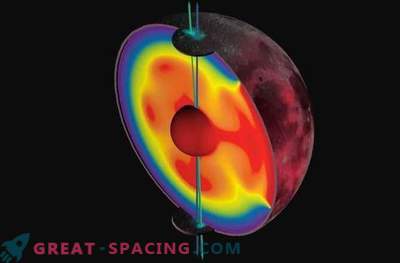
Surprisingly, a certain part of the blame for the earth wobble lies on people! Since 1899, the axis of rotation of the Earth has moved by 10.5 m. Now researchers are looking for reasons, believing that a third relates to the melting of ice and rising sea levels, especially in Greenland (human-induced climate change). Another third of the fluctuation is associated with the expansion of the land mass upwards, as the glaciers recede and ease the load. The last part is the error of slow mantle outflow (viscous middle planetary layer).
Staggering Earth
Scientists have long known that the distribution of mass around the Earth determines its rotation. But it does not happen quite smoothly, which was noted in observations of small fluctuations in the movement of stars in the night sky. Since the 1990s space measurements have also confirmed that the earth's axis of rotation shifts a few centimeters per year. As a rule, this occurs in the Hudson Bay in the north-eastern part of Canada.
The researchers understood that part of the fluctuation was caused by ice isostatic adjustment (the process has been going on since the last ice age 16,000 years ago). When the glaciers recede, they release the surface under their own mass. For thousands of years, the Earth reacts to this by raising itself.

Three factors affecting the Earth's oscillation: loss of ice in Greenland (blue), elevation of the surface during melting of glaciers (orange-yellow) and convection in the mantle layer (red)
However, a new study indicates that the icy isostatic adjustment is responsible only for the near-season fluctuation of 5.5 cm per year. That is, this is only a third of the fluctuation. To fill the gap, scientists created a computer model of the physics of the Earth's rotation, introducing data on the changing balance of land and ocean waters during the 20th century. The researchers also took into account other changes in land and water, such as depletion of groundwater and the creation of artificial reservoirs.
It turns out that these environmental processes annually lead to another 4.3 cm fluctuations. A particularly important factor is the melting of the ice sheet in Greenland. The fact is that this territory released a huge water volume, which was previously locked on land, and the mass was redistributed.
Main Considerations
Melting glaciers still accounted for a third of the reason, so I had to dig deeper. The researchers found that the earth's mantle is devoid of static and moves through the process of convection: the hotter material rises near the core, and the cold one descends. The addition of convection to the earth oscillation model made it possible to find the last third of the influence on rotation during the 20th century. It is important to understand that these fluctuations will not lead to any environmental disasters. It does not affect agriculture or climate. However, it makes it possible to understand where the Earth’s mass is and how it moves. For example, over the past 15 years, the melting of Greenland has become a significant contribution to changing the location of the axis, which pushes the drift eastward. All these data are important for climatologists who track mass displacements.











































